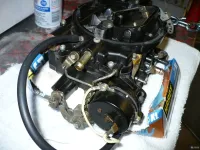I did my first "leak" down test today (misspelling on the title, and I can't figure out how to change it). I used the 'stick something in the spark plug hole' method to find TDC. I think twice I missed it, but I repeated those cylinders. Based on my results, I think I've got problems. But I wanted to see if anyone could find a flaw in my process.
Equipment, OTC leak down tester that has two gauges, both in PSI. Pancake air compressor. I started at cylinder 1. That one I didn't follow instructions on (instructions on tester said to equalize left hand gauge at 90, I did 100 based on a YouTube video). I did that for cylinder 2 as well, I think. I followed the firing order listed on my intake manifold (1843572). After round 1, I started the motor to make sure I didn't screw anything up. then I did two more cylinders (3 and 2) once more. And as I sit and write this down, I see I missed cylinder 6. Damnit. Either way, here are my results for each:
Cylinder 1: Left gauge (LG) 100 (no notes after equalized), Right gauge (RG) 19
Cylinder 8: LG 100, RG 16
Cyl 4: LG 90 -->81 (after equalized), RG 14
Cyl 3: LG 90-->84, RG 15 (initial test tail pipe hiss, but I think I missed TDC)
Cyl 3, round 2: LG 90-->80, RG 43 (oil filler cap was blowing some smoke)
Cyl 5: LG 90-->85, RG 14 (a little hiss from carb, but again, might have missed TDC).
Cyl 7: LG 90-->80, RG 14 (tail pipe)
Cyl 2: LG 90-->72, RG 12 (carb hissed, I rotated motor until it stopped hissing, thinking I missed TDC again).
Cyl 2, round 2: LG 90-->78, RG 62, (oil filler cap hissing).
So, if my understanding is correct, if I missed TDC, I might hear hissing from carb or exhaust. But I shouldn't hear anything from the oil filler cap, even if I missed TDC, right? No bubbles in radiator.
I think I've got bad rings in cylinders 2 and 3. Maybe some valve problems in 5 and 7. But, I suspect those issues are more attributed to my noob status than engine problems.
Thoughts? I also took photos of my spark plugs for each cylinder, but can't figure out how to download them just right now. I saw a lot of carbon deposits on 3, and 2 looked light brown on the ceramic part.
Sorry for this mess of data. It's in a spreadsheet on my computer, but I don't know how to paste it. Anyway, am I looking at a rebuild? Or did jack my methods up so bad that I need to do it again? Thanks.
Jeff
jpcobe is online now Report Post




